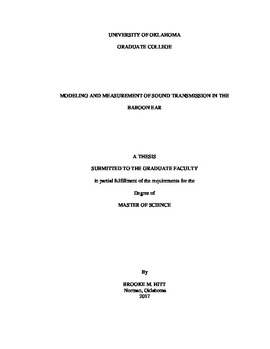| dc.description.abstract | While many animal models exist for middle ear research, the progression of knowledge is hindered by the impossibility of in vivo investigation in cadavers and the great physiological differences of the distantly related species of current animal models. Pediatric and age-related auditory research could be particularly valuable in the effort toward alleviating the enormous fiscal burdens of both middle ear infections in young children and hearing loss in both the young and elderly communities. The goal of this thesis is to provide steps toward the first nonhuman primate model for auditory research and begin the foundation for the role age plays in sound transmission through the primate ear.
Micro-Computed tomography images were used to digitally reconstruct three-dimensional models of one adult and one newborn baboon middle ear, and dimensions were gathered for key tissue components. The adult elliptical tympanic membrane is 0.77 mm greater along the major axis than in the newborn baboon, while it is 0.61 mm smaller along the minor axis, 0.56 mm less deep in conic shape, and ~ 15 µm thinner. The adult ear canal opening was 0.84 mm larger in height and 0.38 mm larger in width. While the adult middle ear cavity was 1.56 mm greater in height, it was also 2.79 mm smaller in the anterior-posterior direction of the skull. Orientation of the ossicles within the middle ear cavity also differed between the adult and newborn baboon ears; the newborn TM was 31.3° more angled from horizontal and the newborn stapes was 14.4° less angled from horizontal. Next, finite element method was employed to analyze the fluid and structural dynamics of sound transmission through the ear canal at different frequencies. Finally, displacement at the umbo of the tympanic membrane was found using the FE model and validated using laser Doppler vibrometry experimental data for old (N=6) and young (N=6) baboon age groups. Treating the experimental mean as the accepted value and the FE results as the results to be compared, this gives a percent error of 21.7% at 200 Hz, 12.5% at 1200 Hz, and 24% at 10000 Hz for the newborn model and 30.7% at 200 Hz, 28.5% at 1200 Hz, and 105% at 10000 Hz for the adult model. Displacement values at very high frequencies deviated most from the experimental mean, and overall the shape of the FE curve is similar to that of the experimental curve. Possible limitations of these analyses include: 1) Each FE model was based on one temporal bone, each coming from a different sex; 2) Because no baboon research exists, human mechanical property values were used for analysis. While the FE models seem to be good representations of their corresponding age groups, further improvements can be made. Based on these preliminary results, age does seem to play an impact in sound transmission for baboons, with TM mobility increasing with age. | en_US |
